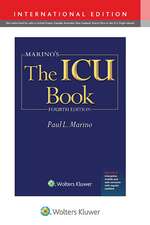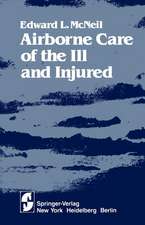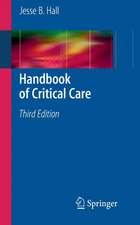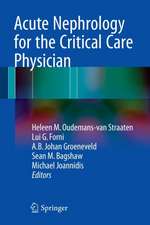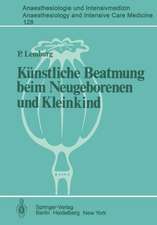Management of Intensive Care: Guidelines for Better Use of Resources: Developments in Critical Care Medicine and Anaesthesiology, cartea 16
Editat de D. Reis Miranda, A. Williams, Ph. Loiraten Limba Engleză Hardback – 31 mai 1990
| Toate formatele și edițiile | Preț | Express |
|---|---|---|
| Paperback (1) | 1408.60 lei 6-8 săpt. | |
| SPRINGER NETHERLANDS – 26 sep 2011 | 1408.60 lei 6-8 săpt. | |
| Hardback (1) | 1415.54 lei 6-8 săpt. | |
| SPRINGER NETHERLANDS – 31 mai 1990 | 1415.54 lei 6-8 săpt. |
Din seria Developments in Critical Care Medicine and Anaesthesiology
- 5%
 Preț: 2122.89 lei
Preț: 2122.89 lei - 5%
 Preț: 362.37 lei
Preț: 362.37 lei - 5%
 Preț: 1101.37 lei
Preț: 1101.37 lei - 5%
 Preț: 1096.98 lei
Preț: 1096.98 lei - 5%
 Preț: 360.70 lei
Preț: 360.70 lei - 5%
 Preț: 1416.45 lei
Preț: 1416.45 lei - 5%
 Preț: 365.61 lei
Preț: 365.61 lei - 5%
 Preț: 1097.91 lei
Preț: 1097.91 lei - 5%
 Preț: 735.66 lei
Preț: 735.66 lei - 5%
 Preț: 369.84 lei
Preț: 369.84 lei - 5%
 Preț: 364.74 lei
Preț: 364.74 lei - 5%
 Preț: 3519.08 lei
Preț: 3519.08 lei - 5%
 Preț: 360.70 lei
Preț: 360.70 lei - 5%
 Preț: 1910.53 lei
Preț: 1910.53 lei - 5%
 Preț: 1799.02 lei
Preț: 1799.02 lei - 5%
 Preț: 2117.38 lei
Preț: 2117.38 lei - 5%
 Preț: 371.66 lei
Preț: 371.66 lei - 5%
 Preț: 367.47 lei
Preț: 367.47 lei - 5%
 Preț: 463.19 lei
Preț: 463.19 lei - 5%
 Preț: 1423.39 lei
Preț: 1423.39 lei - 5%
 Preț: 374.57 lei
Preț: 374.57 lei - 5%
 Preț: 1097.18 lei
Preț: 1097.18 lei - 5%
 Preț: 373.84 lei
Preț: 373.84 lei - 5%
 Preț: 1417.54 lei
Preț: 1417.54 lei - 5%
 Preț: 384.08 lei
Preț: 384.08 lei - 5%
 Preț: 1418.68 lei
Preț: 1418.68 lei - 5%
 Preț: 369.10 lei
Preț: 369.10 lei - 5%
 Preț: 1420.29 lei
Preț: 1420.29 lei - 5%
 Preț: 376.95 lei
Preț: 376.95 lei - 5%
 Preț: 366.19 lei
Preț: 366.19 lei - 5%
 Preț: 349.90 lei
Preț: 349.90 lei - 5%
 Preț: 364.74 lei
Preț: 364.74 lei - 5%
 Preț: 369.10 lei
Preț: 369.10 lei
Preț: 1415.54 lei
Preț vechi: 1490.03 lei
-5% Nou
Puncte Express: 2123
Preț estimativ în valută:
270.87€ • 289.65$ • 225.84£
270.87€ • 289.65$ • 225.84£
Carte tipărită la comandă
Livrare economică 18 aprilie-02 mai
Preluare comenzi: 021 569.72.76
Specificații
ISBN-13: 9780792307549
ISBN-10: 0792307542
Pagini: 246
Ilustrații: XXIV, 246 p.
Dimensiuni: 156 x 234 x 18 mm
Greutate: 0.56 kg
Ediția:1990
Editura: SPRINGER NETHERLANDS
Colecția Springer
Seria Developments in Critical Care Medicine and Anaesthesiology
Locul publicării:Dordrecht, Netherlands
ISBN-10: 0792307542
Pagini: 246
Ilustrații: XXIV, 246 p.
Dimensiuni: 156 x 234 x 18 mm
Greutate: 0.56 kg
Ediția:1990
Editura: SPRINGER NETHERLANDS
Colecția Springer
Seria Developments in Critical Care Medicine and Anaesthesiology
Locul publicării:Dordrecht, Netherlands
Public țintă
ResearchCuprins
I: Introduction.- 1. Intensive Care Medicine.- 2. Guidelines for Intensive Care Medicine.- II: The Patients.- 1. Introduction.- 2. Measuring the type of patients.- 3. Measuring the previous health status and the severity of illness.- 4. Measuring the workload.- 5. Measuring the evolution of severity of illness.- 6. Stratification of patient related data.- References.- Tables.- III: The Facilities.- 1. Introduction.- 2. ICUs in Europe: The great diversity.- 3. The type and size of Intensive Care facilities.- 4. General standard for ICUs.- 5. Staffing.- 6. Comparing facilities.- Addendum I.- Addendum II.- Addendum III.- Addendum IV.- References.- IV: National and Regional Organisation.- 1. Introduction.- 2. Estimating the total number of ICU beds required.- 3. Factors influencing regional planning.- 4. Levels of care.- 5. Calculating manpower needs.- 6. Conclusions.- References.- V: Management Control in the ICU.- 1. Planning and control.- 2. The ICU: Expense or responsibility centre?.- 3. Performance criteria.- 4. Incentives and constraints of ICU performance.- 5. Conclusions.- References.- VI: Education and Training.- 1. Introduction.- 2. The actual education and training of Intensive Care Medicine.- 3. General recommendations.- 4. Conclusions.- Addendum I. Present situation in European countries.- Addendum II. Basic education.- Addendum III. Special education.- Addendum IV. Catalogue of skills for special Intensive Care Medicine training.- Addendum V. General Intensive Care nursing for registered general nurses.- Addendum VI. Special Intensive Care training for nurses in West-Germany.- VII: Evaluation in Intensive Care.- 1. What should or could be evaluated.- 2. Who should evaluate?.- 3 Intensivists should try to adopt common definitions and classifications.- 4. Evaluation studies must have a proper scientific design.- 5. The proper judgement criteria must be employed.- 6. Long term evaluation of Intensive Care: Health status and quality of life.- 7. Economic evaluation of intensive care utilisation.- References.- Table 1. Data for Evaluation of ICM.- Table 2. Components of the Activity of Daily Living.- Table 3. Elements of the Sickness Impact Profile.- Table 4. Components of the Quality of Well Being.- Table 5. Components of the Perceived Quality of Life Index.- Table 6. Costs and Benefits of Intensive Care.- Table 7. Cost Accounting in the ICU.- VIII: Epilogue.- 1. Introduction.- 2. Quantification.- 3. Regionalisation.- 4. Professionalisation.- 5. Levels of responsibility.- 6. Intensive Care Medicine societies.- 7. Concluding comments.- Directory of Intensive Care Organisations.- Subject Index and Abbreviations.- Nigel Turner.








